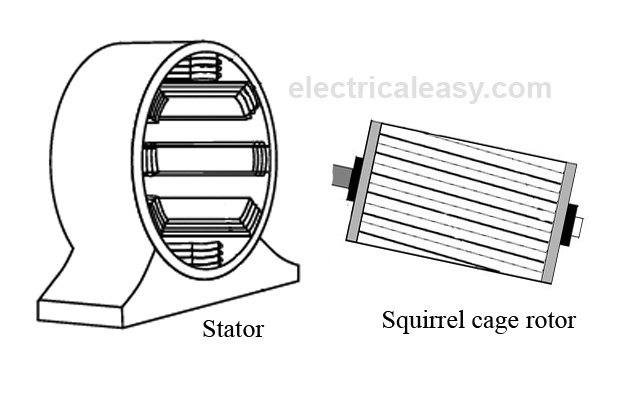Difference Between Squirrel Cage And Wound Rotor Induction Motor Pdf

Cutaway view through stator of induction motor, showing rotor with internal air circulation vanes. Many such motors have a symmetric armature, and the frame may be reversed to place the electrical connection box (not shown) on the opposite side. An induction motor or asynchronous motor is an in which the in the needed to produce torque is obtained by from the of the winding. An induction motor can therefore be made without electrical connections to the rotor.
Hope you know everything fundamental related squirrel cage induction motor. We saw the construction of the Squirrel cage induction motor. The main difference between slip ring and squirrel cage induction motor is the rotor construction. Motors have main two parts in construction: stator and rotor. In these motor, the rotor is squirrel cage type.
An induction motor's rotor can be either or induction motors are widely used as industrial drives because they are self-starting, reliable and economical. Single-phase induction motors are used extensively for smaller loads, such as household appliances like fans.
Although traditionally used in fixed-speed service, induction motors are increasingly being used with (VFDs) in variable-speed service. VFDs offer especially important energy savings opportunities for existing and prospective induction motors in variable-torque fan, pump and compressor load applications. Squirrel cage induction motors are very widely used in both fixed-speed and (VFD) applications. Squirrel cage rotor construction, showing only the center three laminations In 1824, the French physicist formulated the existence of, termed. By manually turning switches on and off, Walter Baily demonstrated this in 1879, effectively the first primitive induction motor. The first -free two phase AC induction motor was invented by Hungarian engineer; he used the two phase motor to propel his invention, the.
The first AC three-phase induction motors were independently invented by and, a working motor model having been demonstrated by the former in 1885 and by the latter in 1887. Automatic mouse and keyboard kryak. Tesla applied for in October and November 1887 and was granted some of these patents in May 1888. In April 1888, the Royal Academy of Science of Turin published Ferraris's research on his AC polyphase motor detailing the foundations of motor operation. In May 1888 Tesla presented the technical paper A New System for Alternating Current Motors and Transformers to the (AIEE) describing three four-stator-pole motor types: one with a four-pole rotor forming a non-self-starting, another with a wound rotor forming a self-starting induction motor, and the third a true with separately excited DC supply to rotor winding., who was developing an system at that time, licensed Tesla’s patents in 1888 and purchased a US patent option on Ferraris' induction motor concept.
Tesla was also employed for one year as a consultant. Westinghouse employee was assigned to assist Tesla and later took over development of the induction motor at Westinghouse. Steadfast in his promotion of three-phase development, invented the cage-rotor induction motor in 1889 and the three-limb transformer in 1890.
Furthermore, he claimed that Tesla's motor was not practical because of two-phase pulsations, which prompted him to persist in his three-phase work. Although Westinghouse achieved its first practical induction motor in 1892 and developed a line of polyphase 60 induction motors in 1893, these early Westinghouse motors were with wound rotors until developed a rotating bar winding rotor. The (GE) began developing three-phase induction motors in 1891.
By 1896, General Electric and Westinghouse signed a cross-licensing agreement for the bar-winding-rotor design, later called the squirrel-cage rotor. Was the first to bring out the full significance of (using j to represent the square root of minus one) to designate the 90º operator in analysis of AC problems. GE's greatly developed application of AC complex quantities including an analysis model now commonly known as the induction motor. Induction motor improvements flowing from these inventions and innovations were such that a 100- induction motor currently has the same mounting dimensions as a 7.5-horsepower motor in 1897. Principle of operation [ ]. See also: There are three basic types of competing small induction motors: single-phase, split-phase and shaded-pole types and small polyphase motors.
In two-pole single-phase motors, the torque goes to zero at 100% slip (zero speed), so these require alterations to the stator such as to provide starting torque. A single phase induction motor requires separate starting circuitry to provide a rotating field to the motor.
- четверг 15 ноября
- 50